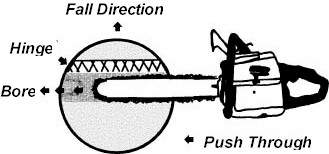Only time I have ever used a bore cut is when felling. The picture posted to me is wrong in the fact that the top of the saw is facing the hinge. When I do bore I come in from the back toward the hinge.
For those of you that are weekend cutters, take a chain and strap the tree above your cut with a heavy chain. I do this if I am topping. If the tree barberschairs on you it can be a deadly situation.
I generally saw a bit of the sides out after boring to make the hinge a bit narrower unless I am trying to pull the tree a bit to one side, but will still take a bit from the nonholding side.
The thing about boring is that when you take the back out of a tree after it has been bored, it really takes off. Not much popping or creaking to let you know it is about to go.
I have dropped a lot of alder and it splits easily. Not taking care to prep the cuts properly can be costly, both to ruined wood and to bodily injury.
As far as bucking, I take, depending on how much energy is stored in the log and which way it is going to want to go, hopefully up or down. Never stand on the outside and cut on a loaded log, no matter how small. As a rule I take out the far side first. If the log wants to drop, I draw the saw across the top, bringing it back toward me and down leaving a small piece of wood in the middle, bore back in to the cut initially taken on the far side and take it out the bottom. I do this while bringing the saw back and forth watching the top cut for movement. If it is opening you are about to pinch, if closing continue to cut, when finished the center should breakout, if not undercutting it is a small thing to release it.
For the ones that want to raise a bit, I do an initial undercut, bringing the bar back and up to take out a 3rd of the side then over the top and down. I try to meet the undercut on the far side before it starts to break, thereby keeping it from slabbing. This all takes time and experience. I have seen folks that get hung on seemingly every cut they put a saw in and their saws show it from jerking the mounts out of them.
Loaded wood is nothing to play russian roulette with. One oldtimer had worked as a faller most of his life was at home doing some backyard cleaning. He touched a loaded vinemaple and it drove the handle of the saw into his chest killing him. It was only a 6inch tree that did that.
Be safe and wear the safety gear, your family needs you.



